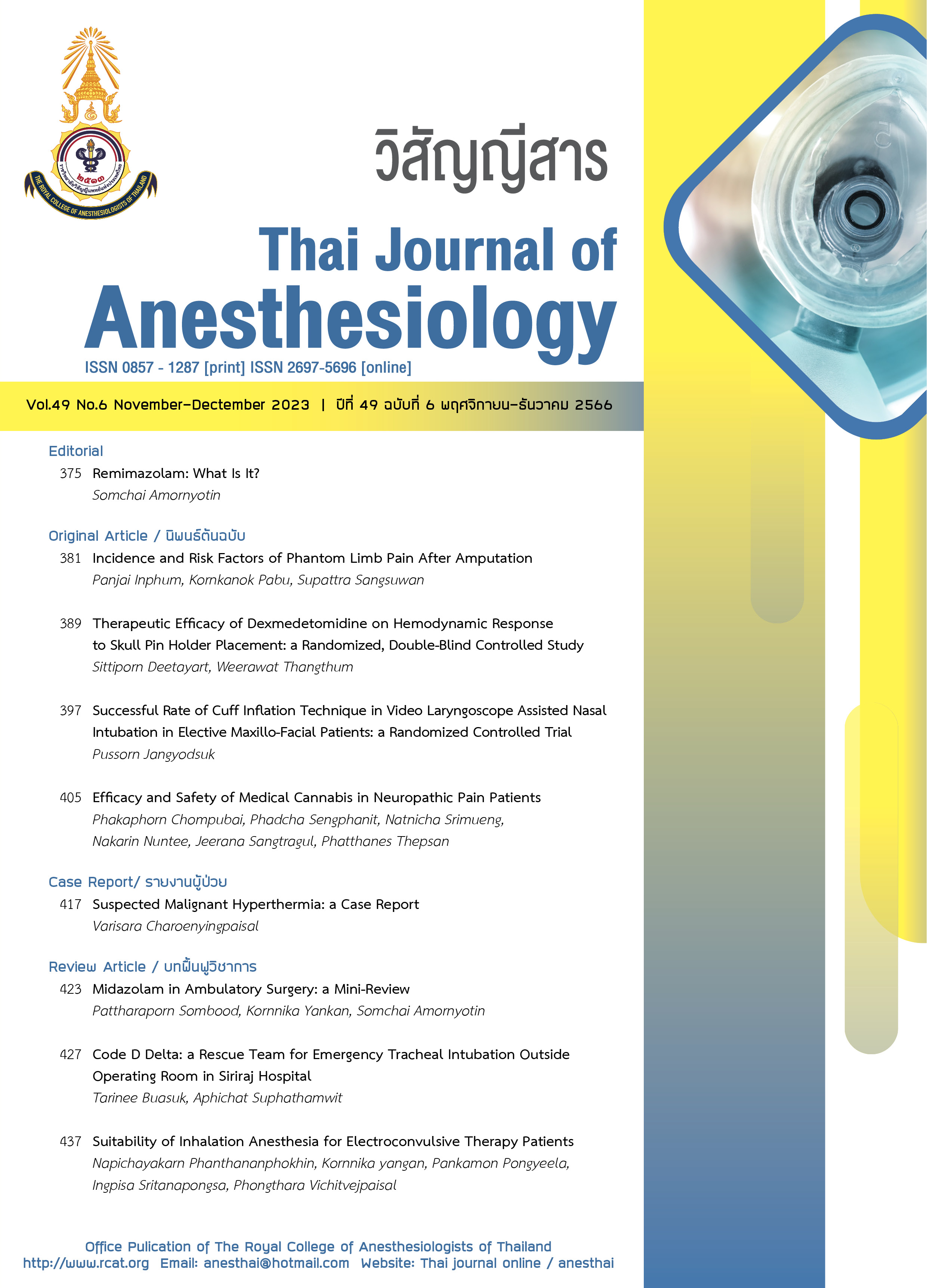Suitability of Inhalation Anesthesia for Electroconvulsive Therapy Patients
Main Article Content
Abstract
Currently, electroconvulsive therapy is applied as a treatment for psychiatric patients, where anesthesia personnel play a crucial role in helping patients manage anxiety, pain, and discomfort during the procedure. Patients are placed under general anesthesia to ensure they are cooperative, peaceful, and unconscious, while doctors and nurses carefully monitor their vital signs to minimize the risk of adverse events or complications such as fractures, organ damage, or aspiration pneumonitis. However, inappropriate anesthesia techniques can lead to side effects such as headaches, muscle stiffness, arrhythmias, confusion, anterograde and retrograde amnesia, which may impact subsequent management. This article delves an alternative technique to intravenous administration of anesthetics is anesthesia with inhalational volatile agents, which is increasingly being used to sedate patients for short periods of time. This technique is suitable for patients who are restless, stressed, fearful of venipuncture, or unwilling to have a vein accessed for fluid administration. Additionally, it allows anesthetists to easily adjust the depth of anesthesia and promotes faster recovery with minimal impact on the circulatory and respiratory systems. As a result, this approach encourages collaboration among multidisciplinary teams in providing safe and effective patient care to achieve treatment goals.
Article Details

This work is licensed under a Creative Commons Attribution-NonCommercial-NoDerivatives 4.0 International License.
References
World Health Organization.Mental disorder [Internet]. 2022 [cited 2023 Aug 11]. Available from https://www.who.int/news-room/fact-sheets/detail/mental-disorders
กรมสุขภาพจิต. กรุงเทพมหานคร; 2565 [เข้าถึงเมื่อ 1 กพ. 2566]. เข้าถึงได้จาก https://dmh.go.th/report/datacenter/dmh/.
Kartalci S, Karabulut AB, Erbay LG, Acar C. Effects of electroconvulsive therapy on some inflammatory factors in patients with treatment-resistant schizophrenia. J ECT. 2016;32:174-9.
McCall WV, Kellner CH, Fink M. Convulsive therapy and the Journal of ECT: 30 years of publication and continuing. LWW; 2014:1-2.
Weiss A, Hussain S, Ng B, et al. Royal Australian and New Zealand College of Psychiatrists professional practice guidelines for the administration of electroconvulsive therapy. Aust N Z J Psychiatry. 2019;53:609-23.
Dunne RA, McLoughlin DM. ECT prescribing and practice. In: Waite J, Easton A, eds. The ECT Handbook. 3rd ed. London: Royal College of Psychiatrists Publications. 2013:28-44.
Lalla FR, Milroy T. The current status of seizure duration in the practice of electroconvulsive therapy. Can J Psychiatry. 1996;41:299-304.
Fink M, Kellner CH, McCall WV. Optimizing ECT technique in treating catatonia. J ECT. 2016;32:149-50.
Gill SP, Kellner CH. Clinical practice recommendations for continuation and maintenance
electroconvulsive therapy for depression: outcomes from a review of the evidence and a consensus workshop held in Australia in May 2017. J ECT. 2019;35:14-20.
Kadiyala PK, Kadiyala LD. Anaesthesia for electroconvulsive therapy: an overview with an update on its role in potentiating electroconvulsive therapy. Indian J Anaesth. 2017;61:373-80.
Sundsted KK, Burton MC, Shah R, Lapid MI. Preanesthesia medical evaluation for electroconvulsive therapy: a review of the literature. J ECT. 2014;30:35-42.
Hasan A, Falkai P, Wobrock T, et al. World Federation of Societies of Biological Psychiatry (WFSBP) guidelines for biological treatment of schizophrenia–a short version for primary care. Int J Psychiatry Clin Pract. 2017;21:82-90.
Milev RV, Giacobbe P, Kennedy SH, et al. Canadian Network for Mood and Anxiety Treatments (CANMAT) 2016 clinical guidelines for the management of adults with major depressive disorder: section 4. Neurostimulation treatments. Can J Psychiatry. 2016;61:561-75.
Franklin AD, Sobey JH, Stickles ET. Anesthetic considerations for pediatric electroconvulsive therapy. Paediatr Anaesth. 2017;27:471-9.
Taylor R, Hadzi-Pavlovic D, Nikolin S, et al. The anaesthetic-ECT time interval with thiopentone-impact on seizure quality. J Affect Disord. 2019;252:135-40.
Leiknes KA, Cooke MJ, Jarosch-von Schweder L, Harboe I, Høie B. Electroconvulsive therapy during pregnancy: a systematic review of case studies. Arch Womens Ment Health. 2015;18:1-39.
Wojdacz R, Swiecicki L, Antosik-Wojcinska A. Comparison of the effect of intravenous anesthetics used for anesthesia during electroconvulsive therapy on the hemodynamic safety and the course of ECT. Psychiatr Pol. 2017;51:1039-58.
Ding Z, White PF. Anesthesia for electroconvulsive therapy. Anesth Analg. 2002;94:1351-64.
Toprak HI, Gedik E, Begeç Z, Öztürk E, Kaya B, Ersoy MÖ. Sevoflurane as an alternative anaesthetic for electroconvulsive therapy. J ECT. 2005;21:108-10.
Aoki N, Suwa T, Kawashima H, et al. Sevoflurane in electroconvulsive therapy: a systematic review and meta-analysis of randomised trials. J Psychiatr Res. 2021;141:16-25.
Jadeja C, Jadliwala R, Mangal D, Gohil DM, Chhaya VA. Comparative study of sevoflurane and sodium thiopentone in electroconvulsive therapy. J Med Sci Clin Res. 2014;2:628-32.
Erdil F, Ozgul U, Sanli M, Kayhan G, Çolak C, Durmus M. The effects of remifentanil on hemodynamic response attenuation after electroconvulsive therapy under sevoflurane anesthesia. J ECT. 2017;33:264-7.
Yatomi T, Uchida T, Takamiya A, et al. Impact of sevoflurane and thiopental used over the course of electroconvulsive therapy: propensity score matching analysis. Front Hum Neurosci. 2022;16:933622.
Wajima Z, Shiga T, Yoshikawa T, Ogura A, Inoue T, Ogawa R. Propofol alone, sevoflurane alone, and combined propofol-sevoflurane anaesthesia in electroconvulsive therapy. Anaesth Intensive Care Med. 2003;31:396-400.
Begec Z, Kayhan GE, Toprak H, et al. Sevoflurane alone and propofol with or without remifentanil for electroconvulsive therapy-a randomised, crossover study. Anaesth Intensive Care Med. 2013;41:202-6.
Rasmussen KG, Laurila DR, Brady BM, et al. Anesthesia outcomes in a randomized double-blind trial of sevoflurane and thiopental for induction of general anesthesia in electroconvulsive therapy. J ECT. 2007;23:236-8.
Shah B, Suryawanshi C, Naramaneni S, Dua M.
A comparative study of sevoflurane vs thiopentone sodium for patients undergoing electroconvulsive therapy. J Med Sci. 2016;6:727-31.
Matsubara T, Yamamoto H, Hikawa Y. Anesthesia for electroconvulsive therapy-comparison of propofol with sevoflurane. Masui. 2012;61:733-7.
Ulusoy H, Cekic B, Besir A, Geze S, Hocaoglu C, Akdogan A. Sevoflurane/remifentanil versus propofol/remifentanil for electroconvulsive
therapy: comparison of seizure duration and haemodynamic responses. Int J Med Res. 2014;42:111-9.
Calarge AC, Crowe RR, Gergis DS, Arndt S, Robert P. The comparative effect of sevoflurane and methohexital for electroconvulsive therapy. J ECT. 2003;19:221-5.
Andrade C. Anesthesia for electroconvulsive therapy: a niche role for sevoflurane. J Clin Psychiatry. 2021;82:21f14173.


